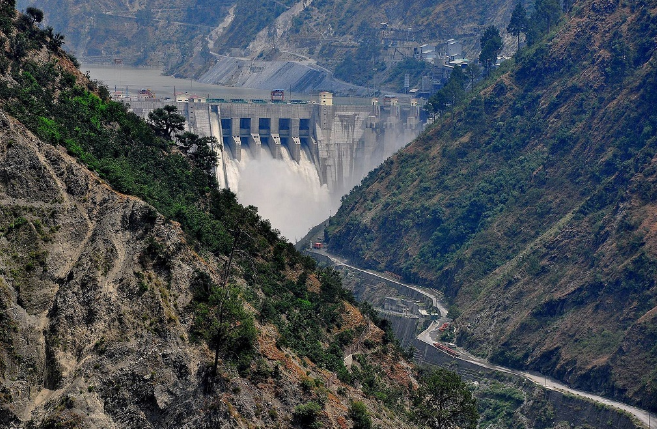By Owais Gul
The looming shadow of climate change is deepening over the Chenab Valley, where scientists and disaster managers warn that a string of mega power projects — once seen as lifelines for energy security — now face existential threats from Glacial Lake Outburst Floods (GLOFs). A new District Disaster Management Authority (DDMA) risk assessment report for Kishtwar has raised alarm bells over the vulnerability of projects like Pakal Dul, Kiru, Kwar, and Dangduru, which together account for thousands of megawatts in planned hydroelectric capacity.
Reportedly, paints a sobering picture. Glacial lakes in the Kishtwar Himalayas have expanded significantly in recent decades, a direct consequence of global warming and accelerated glacial retreat. This expansion, it warns, places not just the projects but entire downstream populations at risk of sudden and devastating floods. “A breach of even a single moraine-dammed lake could unleash walls of water and debris capable of wiping out infrastructure and isolating entire valleys,” the report states.
Hydropower Dreams in Peril
The Chenab Valley Power Projects Limited (CVPPL) projects were designed to harness the roaring Chenab River, but the same river — fed by fragile glaciers and newly formed lakes — has now become a potential destroyer. Rising water levels or sudden breaches could severely damage dams and tunnels, disrupt operations, and trigger a chain reaction of floods downstream. Experts note that the risks are compounded by the fragile geology of the region, already prone to seismic activity and landslides.
Transportation routes — Kishtwar’s lifeline — could also be obliterated. Key roads connecting Padder, Machail, Marwah, Warwan, and Dachhan are in GLOF-prone zones. “If cut off, these areas will become inaccessible at the exact moment when relief and evacuation would be most urgent,” the report warns.
Fragile Ecosystems Under Siege
Beyond human infrastructure, nature itself stands vulnerable. The Kishtwar High Altitude National Park, home to endangered species like the Himalayan brown bear, musk deer, and snow leopard, could face habitat destruction and biodiversity collapse. Environmentalists fear that a large-scale GLOF could irreversibly alter the park’s delicate ecosystems.
Expanding Lakes, Rising Dangers
The DDMA has documented alarming changes, particularly the expansion of Mundiksar Lake over the past 40 years, alongside other high-risk lakes such as Hangu and Patla Pani. Many of these are dammed only by unstable piles of glacial debris — ticking time bombs susceptible to collapse under rising pressure, heavy rainfall, or even minor earthquakes.
Scientific studies from the Central Water Commission (CWC), National Remote Sensing Centre (NRSC), IIT Bombay, University of Jammu, and University of Kashmir confirm the rapid glacial mass loss across the Chenab Basin. The concern is not only about the sheer size of these lakes but also the speed at which they are forming, often faster than authorities can monitor.
Marwah and Warwan: Shadow Zones of Risk
The report singles out Marwah and Warwan tehsils, often called “shadow areas” for their remoteness and lack of infrastructure. Here, scattered villages, subsistence farming communities, and fragile water systems stand on the frontline of risk. With little access to communication and emergency services, these populations would bear the brunt of any sudden flood. Contamination of drinking water and croplands could add a secondary disaster — a public health emergency.
A Multi-Layered Mitigation Strategy
The GLOF Management Plan, embedded in the DDMA’s framework, calls for urgent and layered action. Recommendations include:
- Satellite-based Monitoring: Continuous use of Sentinel-1 and Sentinel-2 imagery to track lake growth.
- Early Warning Systems: Automated sensors to measure water levels, integrated with Indian Meteorological Department forecasts.
- Engineering Interventions: Controlled drainage channels, tunnels to release water, and reinforcement of moraine dams.
- Risk Mapping: Identifying high-vulnerability zones for buffer zones, evacuation corridors, and relocation planning.
- Community Preparedness: Training locals in emergency drills, awareness of warning signals, and self-evacuation strategies.
Experts argue that the time for warnings is past. “Every passing summer, we see lakes swelling. The Himalayas are heating faster than the global average. If mitigation is not taken seriously, it is not a question of if, but when,” a senior glaciologist said.

Chenab River: Sensitive and Unforgiving
The Chenab itself, revered as a mighty river that sustains millions, is becoming increasingly unpredictable. Sudden outbursts upstream could alter its course, inundate low-lying plains, and damage everything in its path. Authorities have been monitoring its changing hydrology, but the unpredictability of GLOFs — capable of generating flash floods within minutes — makes preparedness an uphill battle.
A Call for Climate-Resilient Planning
For Kishtwar and the Chenab Valley, the challenge is no longer hypothetical. The collision between climate change, fragile mountain ecosystems, and massive hydropower infrastructure is already reshaping risk maps. The DDMA’s report makes clear that unless proactive adaptation strategies are mainstreamed into development planning, the valley could face compounded crises — an energy shock, humanitarian disasters, and ecological losses.
The stakes are enormous. Kishtwar’s power projects are not just regional but national assets, aimed at fueling India’s growing energy needs. Yet, the same forces driving global warming are turning the mountains into traps. As one section of the report concludes grimly: “The glaciers that give life to the Chenab may one day unleash floods that erase all human footprints in their path.” (KNO)
The views expressed in this article are solely those of the author and do not necessarily reflect the opinions or views of this newspaper